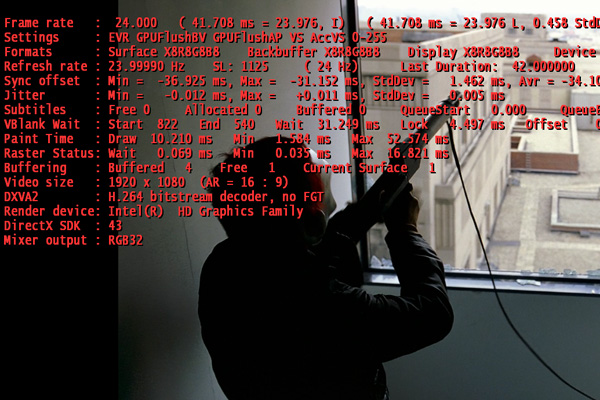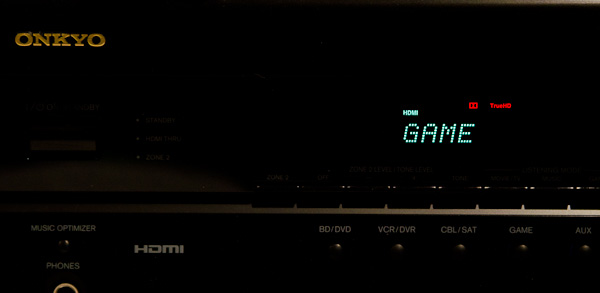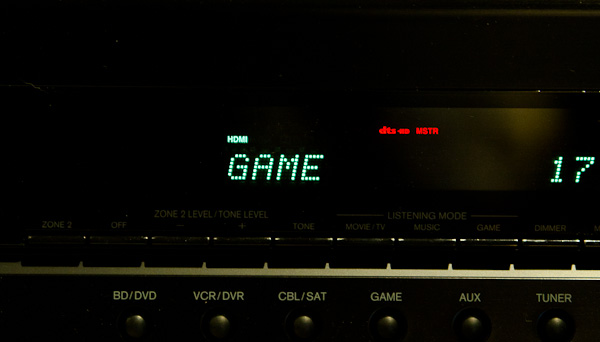The Sandy Bridge Review: Intel Core i7-2600K, i5-2500K and Core i3-2100 Tested
by Anand Lal Shimpi on January 3, 2011 12:01 AM ESTA Near-Perfect HTPC
Since 2006 Intel’s graphics cores have supported sending 8-channel LPCM audio over HDMI. In 2010 Intel enabled bitstreaming of up to eight channels of lossless audio typically found on Blu-ray discs via Dolby TrueHD and DTS-HD MA codecs. Intel’s HD Graphics 3000/2000 don’t add anything new in the way of audio or video codec support.
Dolby Digital, TrueHD (up to 7.1), DTS, DTS-HD MA (up to 7.1) can all be bitstreamed over HDMI. Decoded audio can also be sent over HDMI. From a video standpoint, H.264, VC-1 and MPEG-2 are all hardware accelerated. The new GPU enables HDMI 1.4 and Blu-ray 3D support. Let’s run down the list:
Dolby TrueHD Bitstreaming? Works:
DTS HD-MA bitstreaming? Yep:
Blu-ray 3D? Make that three:
How about 23.976 fps playback? Sorry guys, even raking in $11 billion a quarter doesn’t make you perfect.
Here’s the sitch, most movie content is stored at 23.976 fps but incorrectly referred to as 24p or 24 fps. That sub-30 fps frame rate is what makes movies look like, well, movies and not soap operas (this is also why interpolated 120Hz modes on TVs make movies look cheesey since they smooth out the 24 fps film effect). A smaller portion of content is actually mastered at 24.000 fps and is also referred to as 24p.
In order to smoothly playback either of these formats you need a player and a display device capable of supporting the frame rate. Many high-end TVs and projectors support this just fine, however on the playback side Intel only supports the less popular of the two: 24.000Hz.
This isn’t intentional, but rather a propagation of an oversight that started back with Clarkdale. Despite having great power consumption and feature characteristics, Clarkdale had one glaring issue that home theater enthusiasts discovered: despite having a 23Hz setting in the driver, Intel’s GPU would never output anything other than 24Hz to a display.
The limitation is entirely in hardware, particularly in what’s supported by the 5-series PCH (remember that display output is routed from the processor’s GPU to the video outputs via the PCH). One side effect of trying to maintain Intel’s aggressive tick-tock release cadence is there’s a lot of design reuse. While Sandy Bridge was a significant architectural redesign, the risk was mitigated by reusing much of the 5-series PCH design. As a result, the hardware limitation that prevented a 23.976Hz refresh rate made its way into the 6-series PCH before Intel discovered the root cause.
Intel had enough time to go in and fix the problem in the 6-series chipsets, however doing so would put the chipset schedule at risk given that fixing the problem requires a non-trivial amount of work to correct. Not wanting to introduce more risk into an already risky project (brand new out of order architecture, first on-die GPU, new GPU architecture, first integrated PLL), Intel chose to not address it this round, which is why we still have the problem today.

Note the frame rate
What happens when you try to play 23.976 fps content on a display that refreshes itself 24.000 times per second? You get a repeated frame approximately every 40 seconds to synchronize the source frame rate with the display frame rate. That repeated frame appears to your eyes as judder in motion, particularly evident in scenes involving a panning camera.
How big of an issue this is depends on the user. Some can just ignore the judder, others will attempt to smooth it out by setting their display to 60Hz, while others will be driven absolutely insane by it.
If you fall into the latter category, your only option for resolution is to buy a discrete graphics card. Currently AMD’s Radeon HD 5000 and 6000 series GPUs correctly output a 23.976Hz refresh rate if requested. These GPUs also support bitstreaming Dolby TrueHD and DTS-HD MA, while the 6000 series supports HDMI 1.4a and stereoscopic 3D. The same is true for NVIDIA’s GeForce GT 430, which happens to be a pretty decent discrete HTPC card.
Intel has committed to addressing the problem in the next major platform revision, which unfortunately seems to be Ivy Bridge in 2012. There is a short-term solution for HTPC users absolutely set on Sandy Bridge. Intel has a software workaround that enables 23.97Hz output. There’s still a frame rate mismatch at 23.97Hz, but it would be significantly reduced compared to the current 24.000Hz-only situation.
MPC-HC Compatibility Problems
Just a heads up. Media Player Classic Home Cinema doesn't currently play well with Sandy Bridge. Enabling DXVA acceleration in MPC-HC will cause stuttering and image quality issues during playback. It's an issue with MPC-HC and not properly detecting SNB as far as I know. Intel has reached out to the developer for a fix.














283 Comments
View All Comments
Kevin G - Monday, January 3, 2011 - link
There is the Z67 chipset which will allow both overclocking and integrated video. However, this chipset won't arrive until Q2.Tanel - Monday, January 3, 2011 - link
Well, yes, but one wonders who came up with this scheme in the first place. Q2 could be half a year from now.teohhanhui - Monday, January 3, 2011 - link
I've been thinking the same thing while reading this article... It makes no sense at all. Bad move, Intel.micksh - Monday, January 3, 2011 - link
Exactly my thoughts. No Quick Sync for enthusiasts right now - that's a disappointment. I think it should be stated more clearly in review.Another disappointment - missing 23.976 fps video playback.
has407 - Monday, January 3, 2011 - link
Yeah, OK, lack of support for VT-d ostensibly sucks on the K parts, but as previously posted, I think there may be good reasons for it. But lets look at it objectively...1. Do you have an IO-intensive VM workload that requires VT-d?
2. Is the inefficiency/time incurred by the lack of VT-d support egregious?
3. Does your hypervisor, BIOS and chipset support VT-d?
IF you answered "NO" or "I don't know" to any of those questions, THEN what does it matter? ELSE IF you answered "YES" to all of those questions, THEN IMHO SB isn't the solution you're looking for. END IF. Simple as that.
So because you--who want that feature and the ability to OC--which is likely 0.001% of the customers who are too cheap to spend the $300-400 for a real solution--the vendor should spend 10-100X to support that capability--which will thus *significantly* increase the cost to the other 99.999% of the customers. And that makes sense how and to whom (other than you and the other 0.0001%)?
IMHO you demand a solution at no extra cost to a potential problem you do not have (or have not articulated); or you demand a solution at no extra cost to a problem you have and for which the market is not yet prepared to offer at a cost you find acceptable (regardless of vendor).
Tanel - Tuesday, January 4, 2011 - link
General best practice is not to feed the trolls - but in this case your arguments are so weak I will go ahead anyway.First off, I like how you - without having any insight in my usage profile - question my need for VT-d and choose to call it "lets look at it objectively".
VT-d is excellent when...
a) developing hardware drivers and trying to validate functionality on different platforms.
b) fooling around with GPU passthrough, something I did indeed hope to deploy with SB.
So yes, I am in need of VT-d - "Simple as that".
Secondly, _all_ the figures you've presented are pulled out of your ass. I'll be honest, I had a hard time following your argument as much of what you said makes no sense.
So I should spend more money to get an equivalent retail SKU? Well then Sir, please go ahead and show me where I can get a retail SB SKU clocked at >4.4GHz. Not only that, you're in essence implying that that people only overclock because they're cheap. In case you've missed it it's the enthusiasts buying high-end components that enable much of the next-gen research and development.
The rest - especially the part with 10-100X cost implication for vendors - is the biggest pile of manure I've come across on Anandtech. What we're seeing here is a vendor stripping off already existing functionality from a cheaper unit while at the same time asking for a premium price.
If I were to make a car analogy, it'd be the same as if Ferrari sold the 458 in two versions. One with a standard engine, and one with a more powerful engine that lacks headlights. By your reasoning - as my usage profile is in need of headlights - I'd just have to settle with the tame version. Not only would Ferrari lose the added money they'd get from selling a premium version, they would lose a sell as I'd rather be waiting until they present a version that fits my needs. I sure hope you're not running a business.
There is no other way to put it, Intel fucked up. I'd be jumping on the SB-bandwagon right now if it wasn't for this. Instead, I'll be waiting.
has407 - Tuesday, January 4, 2011 - link
Apologies, didn't mean to come across as a troll or in-your-face idjit (although I admittedly did--lesson learned ). Everyone has different requirements/demands, and I presumed and assumed too much when I should not have, and should have been more measured in my response.You're entirely correct to call me on the fact that I know little or nothing about your requirements. Mea culpa. That said, I think SB is not for the likes of you (or I). While it is a "mainstream" part, it has a few too many warts..
Does that mean Intel "fucked up"? IMHO no--they made a conscious decision to serve a specific market and not serve others. And no, that "10-100X" is not hot air but based on costing from several large scale deployments. Frickin amazing what a few outliers can do to your cost/budget.
Akv - Monday, January 3, 2011 - link
I didn't have time to read all reviews, and furthermore I am not sure I will be able to express what I mean with the right nuances, since English is not my first language.For the moment I am a bit disappointed. To account for my relative coldness, it is important to explain where I start from :
1) For gaming, I already have more than I need with a quad core 775 and a recent 6x ati graphic card.
2) For office work, I already have more than I need with an i3 clarkdale.
Therefore since I am already equipped, I am of course much colder than those who need to buy a new rig just now.
Also, the joy of trying on a new processor must be tempered with several considerations :
1) With Sandy Bridge, you have to add a new mobo in the price of the processor. That makes it much more expansive. And you are not even sure that 1155 will be kept for Ivy Bridge. That is annoying.
2) There are always other valuable things that you can buy for a rig, apart from the sheer processor horsepower : more storage, better monitor...
3) The power improvement that comes with Sandy Bridge with what I call a normal improvement for a new generation of processors. It is certainly not a quantum leap in the nature of processors.
Now, there are two things I really dislike :
1) If you want to use P67 with a graphic card, you still have that piece of hardware, the IGP, that you actually bought and that you cannot use. That seems to me extremely unelegant compared to the 775 generation of processors. It is not an elegant architecture.
2) If you want to use H67 and the Intel IGP for office work and movies, the improvement compared to clarkdale is not sufficient to justify the buying of a new processor and a new mobo. With H67 you will be able to do office work fluently and watch quasi perfectly, with clarkdale you already could.
The one thing that I like is the improvement in consumption. Otherwise it all seems to me a bit awkward.
sviola - Monday, January 3, 2011 - link
Well, the IGP non being removable is like having on-board sound, but also having a dedicated soundcard. Not much of a deal, since you can't buy a motherboard withou integrated sound nowadays...Shadowmaster625 - Monday, January 3, 2011 - link
You say you want Intel to provide a $70 gpu. Well, here's a math problem for you: If the gpu on a 2600K is about 22% of the die, and the die costs $317 retail, then how much are you paying for the gpu? If you guessed $70, you win! Congrats, you now payed $70 for a crap gpu. The question is.... why? There is no tock here... only ridiculously high margins for Intel.